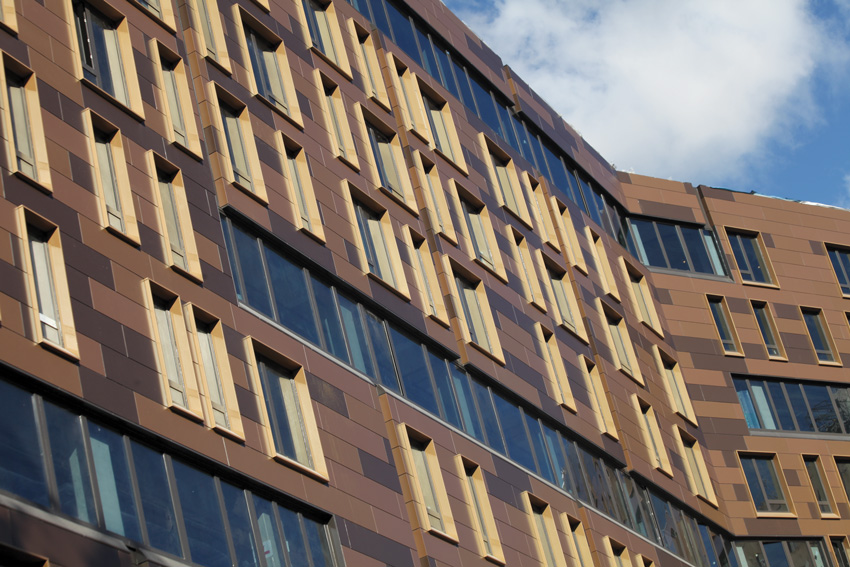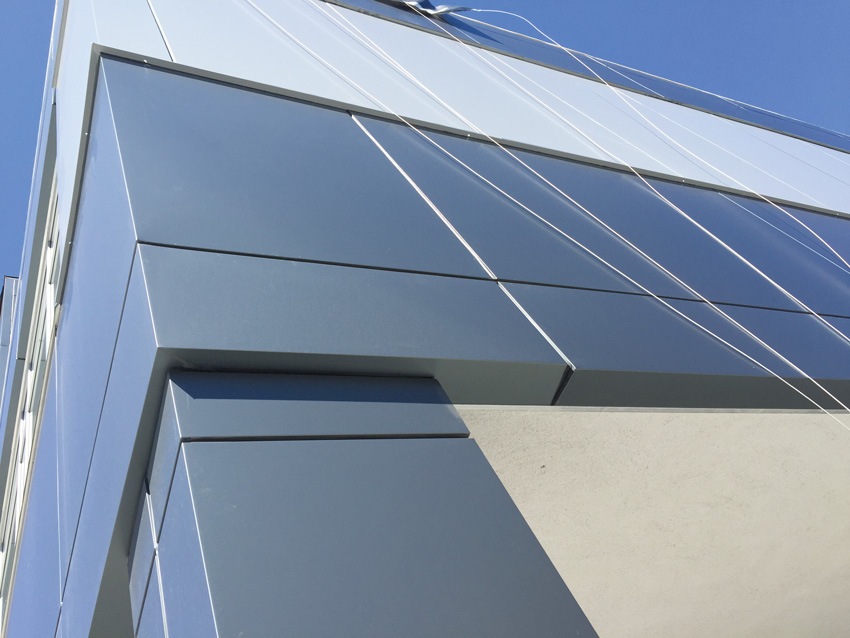Providing Thermal, Moisture, and Fire Barriers In Harsh Conditions
Learning Objectives:
- Identify the aesthetic and performance aspects of flat and three-dimensional cladding as the first exterior barrier of a wall system.
- Assess the need to maintain coordinated, continuous air and water barriers in buildings for energy efficiency, indoor air quality, and sustainability.
- Explain the importance of proper waterproofing systems for foundation and floor decks suitable to the level of protection required.
- Determine the most appropriate fire barrier expansion joint system to use based on building project conditions, safety concerns, and durability requirements.
Credits:
All buildings are designed using a combination of materials, products, systems, and components. Each part is selected and specified to do a particular job, serve a particular purpose, or meet specific criteria. Some are driven by design and aesthetic priorities, while others are driven by functional and performance requirements. The most successful designs are those that allow all of these parts and pieces to work together such that the use of one does not compromise the use of another. In fact, the ideal situation is one where products or components can enhance other materials or systems that are part of the larger building.

Image courtesy of Tremco Commercial Sealants & Waterproofing and BARA (Balfour Beatty Construction, Austin Commercial, H.J. Russell & Co., Azteca Enterprises)
Critical air, water, and fire barrier systems in buildings need to be designed and installed correctly in order to protect both the building and its occupants, as shown here at the Parkland Hospital in Dallas, Texas.
This premise is particularly true where thermal, moisture, and air barriers are involved. By their nature, buildings create a barrier or separation between indoors and outdoors. That separation involves restricting or eliminating the passage of unwanted air or water and controlling unwanted heat transfer. The types of products and systems used to accomplish that separation will determine the effectiveness of the exterior enclosure of a building. But more importantly, the attention to all of the areas where those barriers have seams, connections, penetrations, or irregularities determines the ultimate performance and effectiveness of truly continuous barriers. This is true not only in building exterior enclosures for thermal and moisture protection, but also within a building, where fire barriers are required to protect human life and safety. Walls, floors, and ceilings may be tested and rated, but if the construction is not truly continuous due to openings, joints, or other features, then the effectiveness of the barrier is compromised.
There is one other concern for the long-term integrity of barriers in buildings, namely the conditions they will face over the life of the building. Most of the manufactured barriers or systems available are tested and rated based on typical, or average, conditions. But, depending on their location and use, buildings may experience more difficult or challenging conditions. Some locations constitute harsh environments due to regular exposure to salt water, high winds, or heat and cold. Others are in active seismic zones that can impose numerous stresses from multiple minor earthquakes over the life of the building. Hence, the long-term safety and durability of these barriers, and the buildings and people that they protect, are directly dependent on their capabilities to hold up and function in all of these conditions.
To illustrate these points, we will look at four types of barriers and the issues related to their performance under normal and harsh conditions. Specifically, we will address exterior cladding, air barriers, moisture barriers, and fire barriers.
Enhanced Exterior Cladding
The first line of air and moisture defense on any exterior wall system is the outermost cladding material. Generically, any type of material can constitute cladding, ranging from masonry, stone, metal, wood, or composites. Its purpose is to provide the visible skin of opaque areas of the building and deflect wind, rain, sun, and heat. As such, it needs to be very durable to hold up over time and retain both its appearance and performance characteristics. Usually, this cladding layer is not considered to be air or water tight. Rather, it is intended to take the brunt of weather and sun exposure and protect the building materials and systems behind, while allowing for the management of air and water to drain away. While most cladding materials are up to the challenge, their useful life and need for maintenance will vary by material. Painted surfaces will need repainting, masonry and stone may need repointing, and applied coatings may need recoating. It is not surprising then that factory-finished metal or composite panel systems have become popular for cladding since they often require less maintenance, can be more durable over time, and are lighter weight than some other alternatives.
When thinking about cladding panels, it is common to think of the industry-standard flat panel installations. These may be appropriate for many situations, but their rigidity and ability to withstand high winds or other forces will be directly dependent on the inherent strength of the panel material. If the panel is surface applied directly to a substrate, that may help, but most are designed to be held away from the substrate, creating an intentional drainage space behind the cladding. In fact, the increasingly popular rainscreen systems are specifically designed to perform based on creating just such a space that anticipates water penetrating the cladding joints and being allowed to drain away harmlessly.


Photos courtesy of Acpexpress
Exterior ACM cladding examples include the Brooklyn Bridge Pierhouse (top) in Brooklyn, New York, and 92-77 Queens Boulevard (bottom) in Queens, New York.
An alternative to flat panels is to use metal or aluminum composite material (ACM) panels in three-dimensional (3-D) panel shapes that easily install on building walls. The 3-D shape helps with the rigidity of the panel and avoids distortion or “oil canning” that can occur on some flat panels. Most, if not all, of these products have been independently tested for conformance with ASTM standards for structural load, water penetration, and air infiltration. The test results confirm that these external cladding systems can provide the rain, salt, and wind protection needed for buildings located in harsh environments. Manufacturers of 3-D panels provide a wide array of ACM product offerings, including convex or concave shapes, allowing architects and designers to work creatively.
The primary point of differentiation between fabricators of ACM panels is the attachment systems that each provide, usually made of aluminum or rigid PVC channels and clips. Some attachment systems are based on panels coming together in a butt-butt joint approach that is designed for interior installations but not for exterior facades. Others are based on a removable panel system that allows an ACM panel to be removed and a new panel installed into the same attachment clips, all in a matter of minutes. This can be very useful when sporadic, severe conditions are anticipated and replacements are needed in case of damage, vandalism, etc.
More sophisticated systems remove the need for routed returns on the panels by using the design of the panel and attachment system to join panels together securely. Such systems secure the panels to the building wall without the need for screws, rivets, or caulk. This means that the fabrication and installation process is radically simplified, reducing the overall cost of the installed system and shortening the lead time for getting the panels onto a building. Such systems can be enhanced with thermal break pads that can isolate the aluminum attachments from the building wall, effectively stopping the thermal transfer of energy through the cladding. The thermal break pads commonly available are made from a material called polyamide and are designed to easily affix to the aluminum attachment systems. Polyamide has been found to be very effective at stopping thermal transfer of energy between interior and exterior surfaces. This heat transfer control can be further enhanced using rigid insulation behind the cladding that is penetrated only with Z-channels or hat channels to secure the cladding in place. The combination of thermal break pads and continuous insulation helps provide high R-values for ACM panel installations.
Pablo M. Ipucha, Associate AIA, a senior project manager with Gene Kaufman Architect PC, has experienced the use of such a system, and here is what he has to say about it: “Incorporating ACM panels into a building envelope has benefited us in drastically reducing the width of the exterior wall, while meeting the R-value requirements. We were able to add 6 inches of usable real estate to the floor plans all around.”

Image courtesy of Acpexpress
This ACM cladding system shows thermal break pads, insulated Z-furring, base attachment, stiffener attachments, and un-routed ACM panels. In this case, finishing caps are used to hide the attachment joints.
Notice

www.cladiators.com

www.eproinc.com


www.tremcosealants.com/products/proglaze-eta.aspx










